Alaska, Reliant on Air Transit, Faces Pilot Shortage. Are Drones an
Answer? Matt Gallagher, a pilot for Warbelow's Air,
cleaning snow off a plane in subzero temperatures in Fairbanks. Credit Ruth
Fremson/The New York Times
Matt Gallagher, a pilot for Warbelow's Air,
cleaning snow off a plane in subzero temperatures in Fairbanks. Credit Ruth
Fremson/The New York TimesFAIRBANKS, Alaska - Never climb into an
airplane cockpit in winter without your best military-grade arctic boots, rated
to minus 60 degrees Fahrenheit. Green, cocky pilots fresh from the lower 48 tend
to forget that rule just once. Knowing when not to climb aboard the plane at all
is harder, and comes only with deeper experience.
"If my gut tells me
this is not good, we don't go," said Matt Anderson, 55, who has spent more than
25 years flying small planes across Alaska's wild, empty and hazardous
landscapes.
Generations of pilots like Mr. Anderson once came north for
adventure, and to hone their skills in small planes, flying the Alaskan bush in
the nation's most aviation-dependent state. Their derring-do, in turn, helped
create the Alaskan mystique.
But now a shortage of pilots - global in
scope, fueled by the growth of aviation in Asia and a wave of baby boomer
retirements - is rippling across Alaska with gale force. A state with six times
as many pilots per capita as the rest of the nation, and the need for every one
of them to connect its many far-flung dots on the map, is rewriting the
equations of supply and demand.
Competition is pushing up salaries, and
luring pilots and mechanics to jobs in the lower 48 states. Airlines are
grooming pilots from within, bypassing the old system that made Alaska a proving
ground where a pilot could log the thousands of hours of flight time needed to
qualify for a major airline job. International freight haulers have also hired
away Alaskan pilots as Anchorage, which has the fourth-busiest air-freight
airport in the world in annual tonnage, has become a refueling and crew-change
hub for aircraft flying between Asia and North America.
"The pilot
shortage is affecting the whole commercial aviation industry from the beginning
to the end, the small to the large, and I think Alaska is going to get hit
hard," said Bill Thompson, 47, who left the state in 2015 for a job with a
regional airline in Minneapolis.
From 2011 to 2015, Alaska lost about 12
percent of its commercial-pilot work force, which was in fact slightly less
severe than the 16 percent falloff rate for the nation as a whole, according to
federal figures.
But flying is the lifeblood of commerce, government and
society in a state that is twice the size of Texas and has hundreds of
communities beyond the road system. Gov. Bill Walker jokes that he has three
offices: in Juneau, the capital; in Anchorage, the biggest city; and on a plane
getting back and forth.
 Loretta Fogg and her husband, Matt Anderson, both
pilots, with their son Aidan. "If my gut tells me this is not good, we don't
go," Mr. Anderson said of the challenges of flying in Alaska. Credit Ruth
Fremson/The New York Times
Loretta Fogg and her husband, Matt Anderson, both
pilots, with their son Aidan. "If my gut tells me this is not good, we don't
go," Mr. Anderson said of the challenges of flying in Alaska. Credit Ruth
Fremson/The New York TimesOr consider, for example, the small
passenger and freight airline called Warbelow's Air, based here in Fairbanks in
east-central Alaska. The company needs about nine full-time pilots to meet its
weekly schedule, serving tiny towns north of the Arctic Circle and beyond. But
nine pilots these days have become hard to come by. So this year the company
began recruiting Air National Guard pilots to work part time on their days off,
with six part-timers now adding up to one full-time pilot.
"One pilot out
of six, that's how we fix that problem," said Greg Probst, Warbelow's chief
pilot.
Matt Gallagher, a Warbelow's pilot since 2014, is leaving next
spring for a job in Colorado to be closer to his family, and to seize the chance
to move on to bigger and faster aircraft.
"I want to fly jets that go
40,000 feet in the air for two hours at a time," Mr. Gallagher said. "There are
great opportunities for guys like me."
That flying small planes in Alaska
is a very dangerous line of work is part of the shifting dynamic. From 1990 to
2009, more than a third of all commuter and air taxi crashes in the nation, and
about a fifth of the fatal crashes, occurred in Alaska, according to federal
figures. With only about 730,000 people, Alaska has less than a quarter of 1
percent of the nation's population.
The state's plane crashes and
flat-out disappearances are the stuff of legend. In 2012, a military transport
plane missing since 1952 was found on a melting glacier. A plane that left
Anchorage for Juneau in 1972 carrying two members of Congress, Representative
Hale Boggs of Louisiana - the House majority leader at the time - and
Representative Nick Begich of Alaska, has yet to be found.
Just this year
there have been 91 aircraft accidents or incidents in the state, according to
the National Transportation Safety Board, 13 with one or more fatalities. Alaska
also has most of the nation's active volcanoes, which can spew corrosive ash
into flight paths and engines; Bogoslof, in the Aleutian Islands, erupted just
this month.
Those hazards, on top of a worsening pilot shortage, are
making some researchers and entrepreneurs see opportunity for pilotless drone
aircraft to fill the gap, especially for work that pilots refer to as "the three
d's": flying jobs that are dirty, dull or dangerous.
The University of
Alaska's Center for Unmanned Aircraft Systems Integration, one of six federal
drone research centers, is testing aircraft in arctic conditions, and flying
unmanned craft hundreds of miles out over Arctic waters. Oil companies are
starting to deploy drones to patrol pipelines for leaks or other
damage.
 Mr. Gallagher, center, with colleagues at
Warbelow's Air. He plans to leave for a job in Colorado. "There are great
opportunities for guys like me," he said. Credit Ruth Fremson/The New York
Times
Mr. Gallagher, center, with colleagues at
Warbelow's Air. He plans to leave for a job in Colorado. "There are great
opportunities for guys like me," he said. Credit Ruth Fremson/The New York
TimesResearchers and pilots say they see a time - sooner or later,
depending on when federal safety regulation might allow it - when mail, medicine
or groceries might be delivered to remote villages by drone.
"Is it
technologically feasible to do it right now? The answer is yes," said Nickolas
D. Macchiarella, a professor of aeronautical science at Embry-Riddle
Aeronautical University in Daytona Beach, Fla. "And one of the first places it
could occur is Alaska."
Ben Kellie, 30, founded a drone company in
Anchorage last year, K2 Dronotics with Nick, 27, his brother. Their father, Mike
Kellie, was a swashbuckling bush pilot of the old school, they said, who arrived
in Alaska with a duffel bag and $500 to his name, wanting only to fly. Drones,
said Ben Kellie, the company's chief executive and chief engineer, are the
future, and are less likely to produce injuries or harm if they
crash.
"In Alaska, you can fly for hundreds of miles, and if you have
issues you're going to hit tundra, or a spruce tree," he said.
Carl
France once considered the pilot's life, but decided that the future was
pilotless.
"I decided I'd get bored, flying back and forth from the same
place," said Mr. France, 30, the chief executive of a drone start-up called
Aquilo, which is based in Fairbanks and was founded by engineers from the
University of Alaska.
Aquilo and K2 Dronotics are both focused, at least
for now, on commercial data collection - Aquilo in scientific and industrial
applications, K2 Dronotics in remote-area mapping.
Mr. Anderson and his
wife, Loretta Fogg, 55, who is also a commercial pilot, said the idiosyncrasies
of Alaska - the weather, the terrain, the difficulty in getting help if trouble
arises - bred a mentality of improvisation and intuition about how to keep
passengers and oneself safe.
In flying small planes, often with fewer
than nine passengers - likely as not to be repeat customers traveling to and
from villages - the pilots get to know people and their lives. With pilots
increasingly being drawn to greener - and warmer - pastures, some of that old
hands-on intimacy and continuity could fade.
"I know families, and I know
their kids," Ms. Anderson said. "Where else are you going to get that?"







